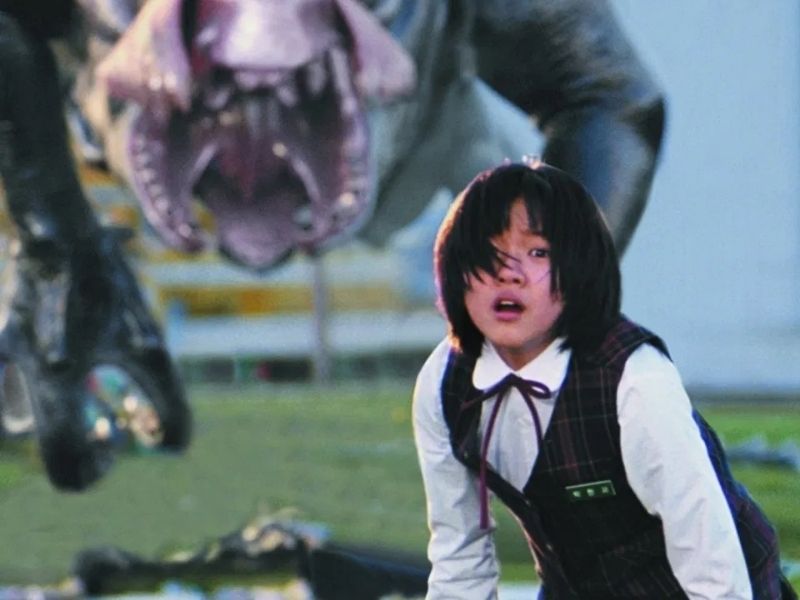“In a word… her birth was an accident, and so was her death. Old people have always said… that an animal which kills a human… should be torn limb from limb. That it’s a human’s duty to do so. Until I slit that beast’s stomach… and at least find Hyun-Seo’s body… I’ll never leave this world in peace.”
Bong Joon-Ho loves creating monsters in his films. From serial killers to the notion of capitalism, his films are always establishing and evaluating the monstrosity and antagonism that plagues the world. However, in his 2006 film The Host which is now streaming on Netflix, the film has a literal monster that has a slimy, amphibian-like skin and an affinity for gobbling down young children.
The film effectively weaves in comedy, melancholy, pathos, love and horror within the quintessential framework of a dysfunctional family. It’s something that is regarded as an artistic characteristic of Bong. For example, in Parasite the whole family dynamic challenged the values of morality. In The Host, a similar family overcomes the barriers of conflict and dysfunctional behaviour to unite against a common evil.
Thanks to the various bizarre folds on the mouth of the huge monster that exists within the minds of the bureaucrats, the special effects are somewhat laughable. The monster is a weird concoction of Godzilla and a dinosaur as it has hunched legs, a scaly tail and a mouth that could rival the famous lizard’s earth-shattering screams. The film ignited some anti-American sentiments in South Korea following its release as it satirised the real-life incident involving the Americans dumping Agent Orange in the Han River. The film begins with an American scientist ordering his Korean assistant to dump a substance called Agent Yellow into the Han river that acts as a violent mutagen and births the monster.
The fact that Bong chose to expose the monster from the very beginning of the film was surprising and equally laudable. He does not keep the creature in an amorphous haze of the unknown. Despite knowing what it looks like, the sudden appearances are enough to make the viewers’ blood run cold.
The beautiful shots throughout the film, capturing the entire landscape as well as the monster’s brutal activities, including the beast hanging from the Seoul bridge before launching a massive attack on the civilians, add to the harrowing sense of the film. However, the question arises, 15 years later, why is The Host still a pertinent watch? Why do we still need to watch a film that reeks of backdated CGI effects and a more or less predictable plot?
The monster in the film is not the protagonist. Its presence brings out the struggles and strife of a Korean middle-class family by the name of Park, where a little young girl becomes the monster’s dinner. Her father is somewhat a dumb and slow alcoholic, a trait common in the males of the family, while her aunt is an over-achieving shooter. Hyun-Seo is captured by the monster yet manages to hide in a swerve tunnel from where she contacts her father, seeking his help. The family set aside all their differences and unite to help find the youngest member, who is the apple of their eyes. However, in the very end, they do not succeed in saving her.
Yet, her father, Park Gang-du, manages to save another young homeless boy named Se-Joo, whom he adopts and spends his life with, as seen in the final scene. The actors are a staple of Bong, and they do brilliant jobs individually, managing to portray the palpable paranoia, anxiety, fear, grief and rage via the screens.
With a pointed political narrative providing a scathing commentary on the toxic and vicious results of the American presence in Korea, and despite Bong’s repeated reiterations of The Host not being an anti-American film, the narrative tends to expose the ill-effects of the superpower’s international interference. Bong takes on this huge subject with a radical sense of humour. He is unabashed and unapologetic in the brazenness of the film, something that is complemented by the lack of subtlety and cover-up. The political activists in the picture add to the overall socio-political commentary that is a characteristic of Bong’s films.
He does not make an attempt to shroud the evil, both physical and meta-physical. The monster appears from the very first scene, the scientists are very vocal about their desire to lobotomise Gang-du, and the whole angle towards the societal stereotypes and poverty add to a heady mix. While a lot of viewers might feel a little alienated from the whole point of the satire, it is important to understand the corruption and overall western hostility the film exposes, given the whole history of totalitarianism and other turbulence that has plagued the South Korean political landscape. The references to the inadequacy of the South Korean government serves their purpose.
Bong raises pertinent questions about the position of the financially weak who are devoid of power and their position in society in the wake of such a disastrous calamity. The Americans’ theory of an Asian flu virus spread shows how easily they are ready to let go of their responsibility despite having been the cause for it. It rings a bell, right?
The political satire is infused cleverly within a genre-bending sci-fi film, making The Host one of Bong Joon-Ho’s masterpieces and a defining film in the monster genre in the current century.
